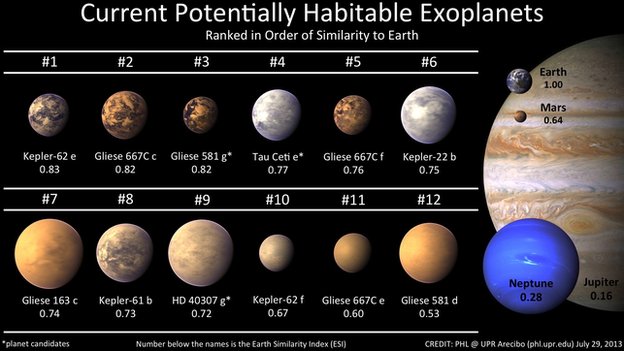
The number of observed exoplanets – worlds circling distant stars – has passed 1,000.
Of these, 12 could be habitable – orbiting at a distance where it is neither “too hot” nor “too cold” for water to be liquid on the surface.
The planets are given away by tiny dips in light as they pass in front of their stars or through gravitational “tugs” on the star from an orbiting world.
These new worlds are listed in the Extrasolar Planets Encyclopaedia.
The tally now stands at 1,010 new exoplanets, bolstered by 11 new finds from the UK’s Wide Angle Search for Planets (Wasp).
Abel Mendez of the Planetary Habitability Laboratory at the University of Puerto Rico, said that although the number has rapidly increased in recent years, due to a lack of funding this figure is much lower than it could be.
“We have more techniques and proven technology to detect more exoplanets, but the limit has been telescopes, especially space telescopes.
“If we had more funding there would be more telescopes and that count would be much larger by now.”
The Kepler space telescope, which spotted many of these worlds in recent years, broke down earlier this year. Scientists still have to trawl through more than 3,500 other candidates from this mission so the number could rapidly increase.
In January 2013, astronomers used Kepler’s data to estimate that there could be at least 17 billion Earth-sized exoplanets in the Milky Way galaxy. They said that one in six stars could host an Earth-sized planet in close orbit.
The number of confirmed planets frequently increases because as scientists analyse the data they are able publish their results online immediately. But as the finds are not yet peer reviewed, the total figure remains subject to change.
“Each night we get a list of astronomy papers where there might be an exoplanet announcement. When we get that we have to review it,” explained Prof Mendez.
This exoplanet catalogue is organised by Jean Schneider, an astronomer at the Paris Observatory. For the past 18 years he has catalogued new exoplanets on the Extrasolar Planets Encyclopaedia.
Full article: http://www.bbc.co.uk … environment-24549384
